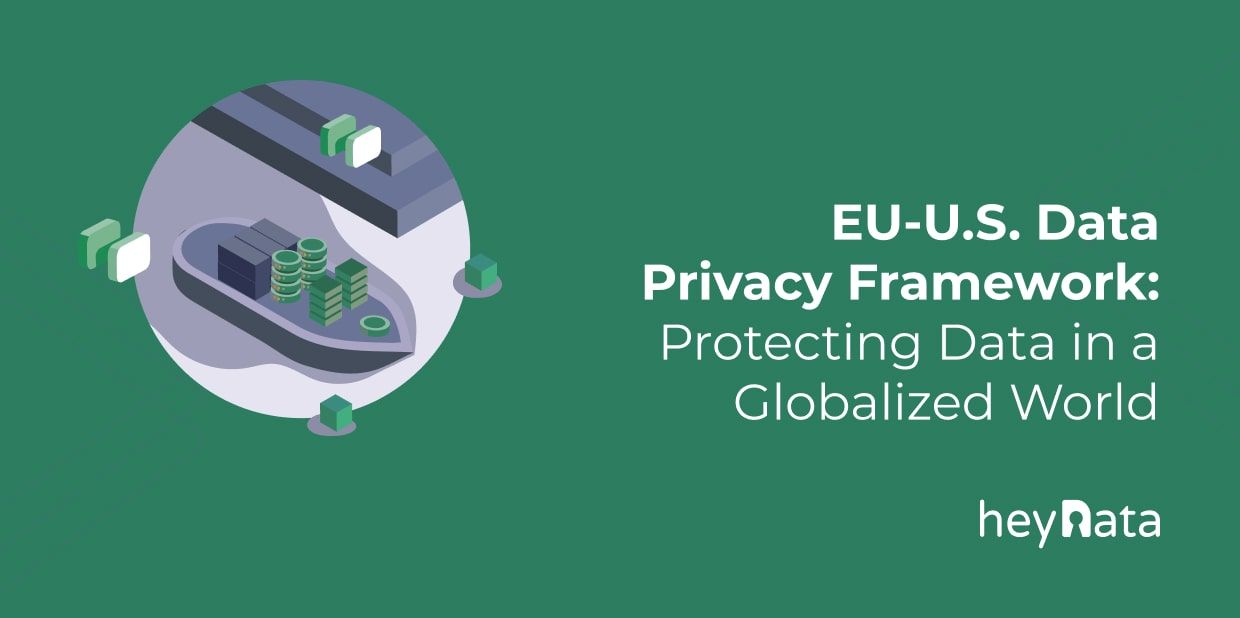
EU-U.S. Data Privacy Framework: Protecting Data in a Globalized World

In today's interconnected world, where data flows freely across borders, ensuring the privacy and protection of personal information has become a top priority. The EU-U.S. Data Privacy Framework (DPF), finally adopted on July 10, 2023, emerges as a significant development that addresses the challenges of data protection in transatlantic data transfers. In this blog post, we will explore the importance of the EU-U.S. Data Privacy Framework, its impact on data transfers between the European Union (EU) and the United States (U.S.), and the measures put in place to safeguard data privacy.
Understanding the EU-U.S. Data Privacy Framework
The EU-U.S. Data Privacy Framework is a mechanism that ensures compliance with EU data protection requirements when transferring personal data from the EU to U.S. organizations. It is the latest iteration of data transfer mechanisms, succeeding the Safe Harbor and Privacy Shield frameworks, which were invalidated by the Court of Justice of the European Union (CJEU). This framework provides a legal basis for data transfers and aims to bridge the gap between the data protection standards of the EU and the U.S.
The Need for Effective Data Transfer Mechanisms
In an era where data drives global business operations, having a robust data transfer mechanism is essential. The EU General Data Protection Regulation (GDPR) and its UK equivalent, the UK GDPR, impose restrictions on transferring personal data to countries without an adequate level of protection. The EU-U.S. DPF addresses this need by offering a mechanism that enables secure data transfers to the U.S., without compromising data protection standards.
A Journey Towards a More Secure Data Transfer Framework (DPF)
The path to the adoption of the EU-U.S. Data Privacy Framework has been marked by extensive negotiations and collaborative efforts between EU and U.S. executives. Let's take a closer look at the key milestones that led to its implementation.
In March 2022, Presidents von der Leyen and Biden reached an agreement in principle on a new transatlantic Data Privacy Framework. This laid the foundation for subsequent developments, including the signing of an Executive Order by President Biden in October 2022. The Executive Order introduced binding safeguards and addressed concerns raised by the CJEU in its Schrems II decision in July 2020.
In December 2022, the European Commission published a draft adequacy decision endorsing the proposed EU-U.S. DPF. The European Data Protection Board adopted its opinion on the draft decision in February 2023, providing valuable insights and recommendations. Finally, in July 2023, the framework gained approval from Member State representatives and officially entered into force.
Key Components of the EU-U.S. Data Privacy Framework
The EU-U.S. Data Privacy Framework incorporates several essential elements that ensure the protection and privacy of personal data transferred between the EU and the U.S. Let's explore these key components in more detail.
1. Binding Safeguards
One of the core aspects of the EU-U.S. Data Privacy Framework is the introduction of binding safeguards. President Biden's Executive Order established rules that limit access to EU data by U.S. intelligence agencies to what is necessary and proportionate for national security purposes. This addresses the concerns raised by the CJEU and establishes a framework that respects the principles of necessity and proportionality.
2. Redress Mechanism
To enhance accountability and address potential grievances, the EU-U.S. Data Privacy Framework incorporates a robust redress mechanism. Instead of relying solely on the previous Ombudsman model, a new Data Protection Review Court has been established. This court possesses investigative powers and the authority to propose remedies, providing individuals with an effective means to address data privacy concerns.
3. Self-Certification and Oversight
Participation in the EU-U.S. Data Privacy Framework requires U.S. companies to undergo a self-certification process. The U.S. Department of Commerce administers this process and monitors the compliance of certified organizations with the framework's principles. The U.S. Federal Trade Commission acts as the enforcement authority, ensuring that signatory companies uphold their obligations.
Understanding the Implications of the EU-U.S. Data Privacy Framework for Businesses
The introduction of the EU-U.S. Data Privacy Framework (DPF) marks a significant evolution in this complex landscape. Let's delve into the implications of this new framework and its potential impact on businesses across the United States, the European Union, the United Kingdom, and Switzerland.
From Uncertainty to Clarity
Data transfers between the EU and the U.S. have long been shrouded in uncertainty, with ever-evolving regulations and significant penalties for non-compliance. The introduction of the DPF, however, has provided businesses with a clear and explicit roadmap for achieving and maintaining compliance.
The framework mandates a contractual agreement for EU/UK/Swiss-U.S. data transfers, which ensures processors act on the instructions of data controllers, implement appropriate security measures, and uphold individuals' rights under the DPF Principles.
Participation in the DPF program is limited to U.S. organizations under the jurisdiction of either the Federal Trade Commission (FTC) or the U.S. Department of Transportation (DOT). Businesses must confirm their eligibility based on their specific activities and jurisdiction, making this a crucial first step towards compliance. Thus, companies need to verify their eligibility based on their specific activities and jurisdiction. This certification process can streamline data transfers, particularly for multinational corporations, by diminishing the reliance on Standard Contractual Clauses (SCC), though including them as a fallback is still advised.
Continuing Compliance and Future Considerations
Despite the clarity it offers, navigating the EU-U.S. DPF is not a one-time endeavor. It requires businesses to undertake an ongoing journey towards maintaining compliance.
Businesses must be transparent about their data collection and processing practices, including the types of personal data they handle, the purposes for collecting it, and any third-party involvement. They must also provide their customers with options for limiting the use and disclosure of their personal data.
Having a secure system for granting individuals access to their personal data is vital. Businesses need to establish robust dispute resolution mechanisms and have processes in place to respond to complaints swiftly and effectively.
Further, businesses must assume responsibility for the data they handle. They should notify individuals of their potential liability in the event of a data transfer and the need to disclose personal data in response to lawful requests by public authorities.
The Ongoing Journey
Understanding the DPF and its requirements is just the beginning of the journey for businesses. They must be proactive in maintaining compliance, staying abreast of ongoing developments, and adjusting their practices accordingly.
The European Commission's commitment to periodically reviewing the DPF ensures that the framework stays relevant and effective. Such reviews will assess changes in the U.S. legal framework and ensure its continued alignment with EU data protection standards.
This flexibility allows the framework to adapt to emerging challenges and changes in the data protection landscape. It serves as a reminder that in the world of data privacy, change is the only constant.
In short, the EU-U.S. DPF presents both an opportunity and a challenge for businesses. By understanding the framework's requirements and continuously striving for compliance, businesses can navigate this complex landscape effectively, upholding their commitment to data privacy and protection while facilitating cross-border data flows. The journey might be demanding, but the reward – trust of customers and legal compliance – is undoubtedly worth it.
What our experts say: Our co-founder and CLO, Martin Bastius

The EU-US Data Privacy Framework is a big deal in the world of data protection, especially for companies seeking to send data from the EU to the US. Being in close contact with them on a daily basis, I know their pain of the past years where transfers were very difficult. The new framework is a good balancing act between privacy rights and data transfers, serving as a role model for other jurisdictions. As we continue to navigate the complexities of the global data economy, companies need to prioritize data protection and privacy. By establishing robust guarantees and a strong redress mechanism, the framework builds trust and confidence between the EU and the US. However, companies should be aware that they still have to cautiously review and thoroughly document every transfer because the framework only helps for a part of these activities.
Conclusion: Strengthening Data Protection in a Global Context
The EU-U.S. Data Privacy Framework represents a significant step forward in safeguarding data protection in transatlantic data flows. By establishing binding safeguards, implementing a robust redress mechanism, and promoting self-certification and oversight, the framework strikes a balance between privacy rights and the facilitation of data transfers. While the framework sets a precedent for EU-U.S. data flows, it also serves as a model for evaluating and recognizing data protection adequacy in other jurisdictions.
As we navigate the complexities of the global data economy, it is crucial to prioritize data protection and privacy. The EU-U.S. Data Privacy Framework exemplifies a collaborative effort to bridge the gap between different legal systems and foster trust in data exchanges. By upholding strong data protection standards, we can ensure the privacy and security of personal data while promoting innovation and economic growth.
If you have any questions or concerns regarding the EU-U.S. Data Privacy Framework and its implications for data protection, feel free to reach out to our team at heyData. We are here to assist you and provide guidance on navigating the ever-changing landscape of data privacy.


